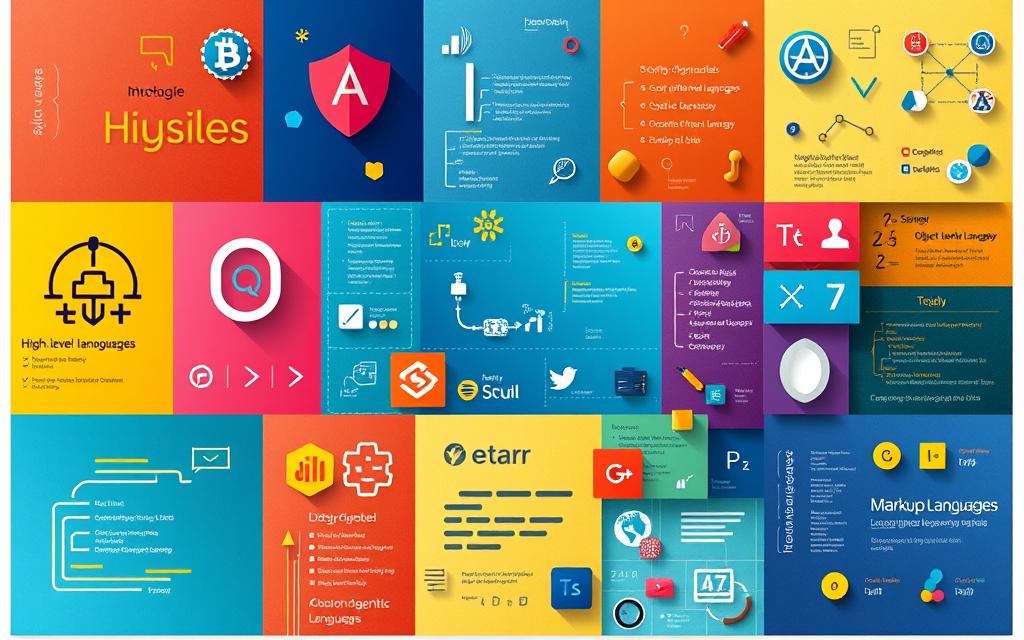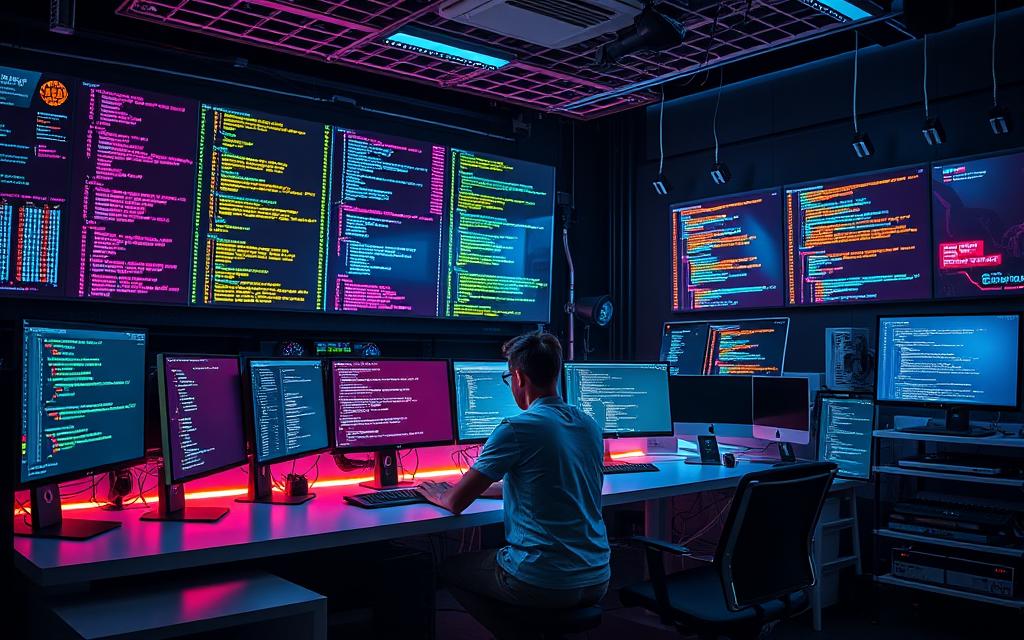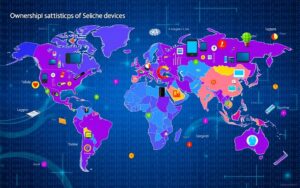What Is Programming in Information Technology?
Programming, or coding, gives computers tasks to do. It uses different languages to create software and apps. Around 162,900 job openings for software developers and testers appear every year. This shows how important coding skills have become.
Programming makes our daily lives easier. It helps with everything from surfing the internet to complex banking. Many IT pros believe coding is key to success. Also, computer programmers earned a median salary of $99,700 in 2023.
Understanding the Basics of Programming
Programming is the backbone of today’s tech world. It involves fundamental coding ideas that let us talk to machines. Grasping these basics is key for those diving into the digital world. By learning different programming languages, coders can solve daily issues in innovative ways.
Definitions and Key Concepts
Programming means writing code in languages that computers understand. This lets machines do specific tasks. It’s built on key concepts like variables, data types, functions, and control structures. Knowing these elements well is crucial for coding success.
JavaScript is super popular among coders, with 62.3 percent using it. HTML and CSS are also key, used by 52.9 and 51 percent of developers. These languages help build and style websites, playing a big role in web development.
The Collaboration Between Humans and Computers
Good programming is essential for smooth user-system interaction. Programmers design logical paths and write code for many uses. For instance, this lets users click around a webpage easily. Skills like teamwork, creativity, and talking well are important for coders. Job ads often list these skills because companies really value them.
| Programming Language | Usage Percentage |
|---|---|
| JavaScript | 62.3% |
| HTML/CSS | 52.9% |
| SQL | 51% |
| Python | 51% |
| TypeScript | 38.5% |
As web development grows, understanding programming opens doors to creativity and new ideas. Realising the value of programming is shaping today’s tech scene.
What Is Programming in Information Technology
Programming is a key pillar for modern technology, sparking innovation in many fields. It counts an impressive 31.1 million software developers around the globe. With technology’s evolution, the demand for different programming languages grows, catering to various digital needs.
The Role of Programming in Modern Technology
Programming is behind the essential software that powers many parts of our daily lives. It turns ideas from computer science into real tools we use every day, like websites and apps. This collaboration between humans and computers boosts productivity, making tasks quicker and easier.
In our digital world, the need for talented programmers is climbing. Their skills help keep our digital world running smoothly and efficiently.
Importance of Different Programming Languages
Diverse programming languages are crucial for creating the best software solutions. Each language is suited for particular tasks. For example:
| Programming Language | Primary Use | Typical Industry |
|---|---|---|
| JavaScript | Web Development | Technology, E-commerce |
| Python | Data Analysis, Machine Learning | Finance, Healthcare |
| C++ | System Software, Game Development | Gaming, Finance |
| SQL | Database Management | All Industries |
Programming languages let people work in various sectors, from gaming to finance. Learning to code isn’t just about technical skills. It opens doors to many career opportunities. As fields like machine learning grow, programmers are key to future technologies.
Types of Programming Languages in IT
The world of programming is broad, with many languages designed for different tasks. It’s crucial for tech enthusiasts and developers to understand these. We’ll look at procedural, functional, and object-oriented programming. Each has unique features and uses in the tech field.
Procedural, Functional, and Object-Oriented Languages
Programming languages vary based on their design patterns. Procedural programming involves a step-by-step instruction approach. It helps developers make medium-sized apps and embedded systems. C and Pascal are examples.
Functional programming focuses on mathematical function-based computation. It’s great for handling lots of data and multitasking. Haskell and Scala are key players here.
Object-oriented programming, or OOP, groups data as objects. This makes it easier to organize, adapt, and reuse code. Java, Python, and C# are popular for software, web applications, and games.
Commonly Used Programming Languages in the Industry
Different programming languages are popular in various fields. Python is known for its broad application in web development, data science, and AI. JavaScript is essential for interactive websites. Java’s reliability makes it perfect for web and mobile apps.
The table below shows important languages and what they’re used for:
| Language | Primary Use |
|---|---|
| Python | Web development, Data science, Automation, AI |
| JavaScript | Interactive web content |
| Java | Web, Desktop, Mobile applications |
| C++ | High-performance software, Operating systems, Video games |
| Ruby | Web development, DevOps automation |
| PHP | Dynamic website development |

High-level and low-level languages differ in human or machine readability. The best language for a project often depends on its requirements and the tech stack used.
How Programming Works: A Brief Overview
Programming helps us understand the digital world better. It involves steps that move a programmer from an idea to reality. Knowing these steps makes software development smoother and more effective.
Steps Involved in the Programming Process
The first step is to figure out the problem you want to solve. Then, programmers write code to solve this in a computer’s language. After writing, they check the code for mistakes to ensure it works well. Finally, they run the code to do the tasks they planned.
Compiling vs Interpreting Code
There are two main ways to run code: compiling and interpreting. Compiling changes the code into machine language before it runs, making it work faster after. Whereas, interpreting reads and runs the code one line at a time. This is slower but helps in fixing errors quickly.
It’s important to know the difference between these methods to make programs run better. Knowing when to compile or interpret can make programming more efficient. For more about programming languages, see this resource.
Conclusion
Programming is vital in the world of information technology. It’s the key to making and running software that we use every day. Learning to code gives people important IT skills. This leads to new ideas and many job chances in a digital age. As tech grows, so does the need for skilled programmers. This means always learning new things in this changing area.
C++ and Java are examples of high-level programming languages. They help programmers make software that’s easy for us to use. This software can do many things. For example, it can help doctors care for patients or promote ways to protect the environment. Programming isn’t just about writing code. It’s also a way to solve problems and be creative. People can turn their ideas into real things.
The future of tech is all about knowing how to code. Companies want people who can handle complex problems and create smart solutions. Schools are teaching programming more and more. This helps young people think in new ways. It gets them ready to bring new ideas to life, in many different areas.
FAQ
What is programming?
Programming, also called coding, involves creating instructions that tell computers what to do. It’s vital for making software that powers everything in the digital world.
Why is programming important in today’s technology?
Programming makes modern tech possible. It drives the systems of many industries. It lets us browse the web, analyse data, and do online banking smoothly.
What are the main types of programming languages?
There are many kinds of programming languages, like procedural and object-oriented. Each has a specific role in creating different types of software.
How does human-computer interaction relate to programming?
Programming is key to how we interact with computers. Through code, programmers build interfaces that make using computers a good experience.
What are some commonly used programming languages?
Popular languages include Java, Python, and JavaScript. These languages are known for their flexibility. They’re used in many tech fields today.
What steps are involved in the programming process?
Programming involves first identifying a problem. Then, you write code and test it for errors. Finally, you run the code to see if it works as expected.
What is the difference between compiling and interpreting code?
Compiling turns code into machine language before it runs. Interpreting translates code as it’s run, line by line. Both methods are important for making software efficient.
How can I learn programming?
To learn programming, you can take courses, attend workshops, or use online tutorials. Start with the basics, then move on to learn different languages and frameworks.









